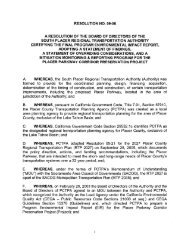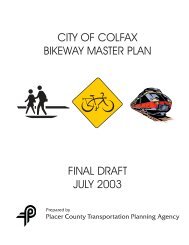Bus Rapid Transit (BRT) Implementation Study for South ... - pctpa
Bus Rapid Transit (BRT) Implementation Study for South ... - pctpa
Bus Rapid Transit (BRT) Implementation Study for South ... - pctpa
Create successful ePaper yourself
Turn your PDF publications into a flip-book with our unique Google optimized e-Paper software.
<strong>Bus</strong> <strong>Rapid</strong> <strong>Transit</strong> (<strong>BRT</strong>) <strong>Implementation</strong> <strong>Study</strong> <strong>for</strong> <strong>South</strong> Placer CountyEnhanced Stops provide additional <strong>BRT</strong> station features such as weatherprotection and lighting. It also incorporates additional design treatmentsincluding walls, high-quality material finishes, and passenger amenities such asbenches, pay phones, or trash cans. In general, the cost of an enhanced stopranges from $25,000 to $35,000 per shelter (does not include cost of plat<strong>for</strong>m orsoft-costs).Designated Stations provide more complex <strong>BRT</strong> station featuressuch as level passenger boarding and alighting, separate connectionbetween plat<strong>for</strong>ms or between plat<strong>for</strong>m and passenger amenities. Ingeneral, the cost of a designated station ranges from $150,000 to$2.5 million per station (does not include cost of parking facilities orsoft-costs).Intermodal Terminal or <strong>Transit</strong> Center It is the most complex andcostly type among the current <strong>BRT</strong> stations. It usually consists oflevel passenger boarding, a host of amenities, and transfer facilitiesbetween <strong>BRT</strong> service and other public transit modes (e.g., local busand rail transit). In general, the cost of this type ranges from $5 to$20 million (or higher) per facility (does not include soft-costs).Station Location and Spacing<strong>BRT</strong> station location and spacing are critical factors to affect patronage and operating speeds. TCRP Report90 defines the following principles to be considered to determine the <strong>BRT</strong> station location and spacing.• <strong>BRT</strong> station should be located at major passenger concentrations (e.g., high-density residentialareas, high-density employment areas, universities and high schools, and recreational centers).• <strong>BRT</strong> station should be located near major bus routes and major arterial roadways.• <strong>BRT</strong> station should be placed as far apart as possible and the recommended guidelines <strong>for</strong> <strong>BRT</strong>station spacing by arrival mode are show below.44





